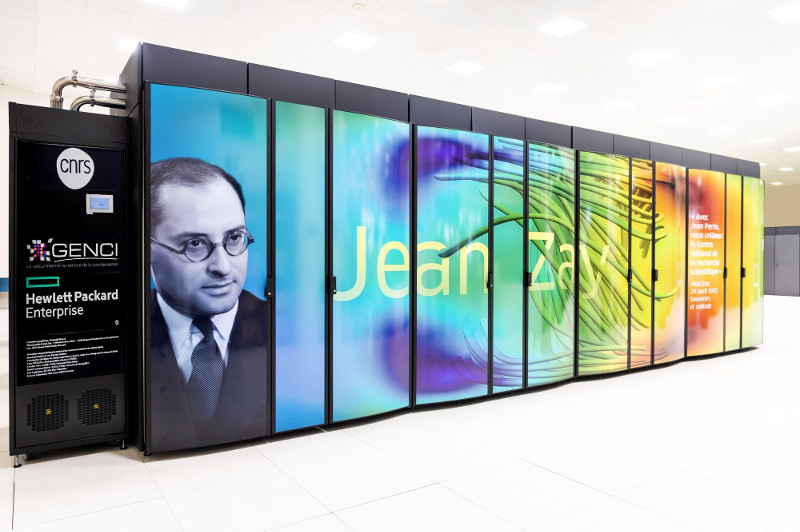
Table des matières
Jean Zay: Introduction
Jean Zay is the new supercomputer converged platform acquired by the French Ministry of Higher Education, Research and Innovation through the intermediary of the French civil company, GENCI (Grand Equipement National De Calcul Intensif). This acquisition was signed into contract with Hewlett Packard Entreprise (HPE) on 8 January 2019.
The new computer was installed at IDRIS, national computing centre for the French National Centre for Scientific Research (CNRS), during the first six months of 2019. It has a peak performance of 14 Pflop/s (14 million billion floating point operations per second) and permits the extension of classic usage modes of high performance computing (HPC) for new usages in artificial intelligence (AI).
A new procedure has also been determined with GENCI to facilitate access to this computer for the entire artificial intelligence research community for which the needs and work methods strongly differ from those of the HPC community.
Hardware configurations of the Jean Zay supercomputer
Jean Zay is an HPE SGI 8600 computer which is partitioned into two sections. The first section is composed of scalar nodes and the second section of “converged” nodes, or more precisely, “converged accelerated hybrid nodes”. These hybrid nodes are equipped with both CPUs and GPUs which will permit the usages associated with both HPC and AI. The second section contains more than 1000 GPUs. All the compute nodes are interconnected by an Intel Omni-Path network and access a shared file system with very high bandwidth.
- 1528 XA730i compute nodes, with 2 Intel Cascade Lake 6248 processors (20 cores at 2.5 GHz), or 40 cores per node
- 261 XA780i converged nodes, with 2 Intel Cascade Lake 6248 processors and 4 Nvidia V100 SXM2 GPUs (32 GB each)
- Cumulated peak performance of 13.9 Pflops/s
- Each node will have 192 GB of memory
- Omni-Path interconnection network 100 Gb/s (1 link per scalar node and 4 links per converged node)
- 5 frontal nodes (with 2 Intel Cascade Lake 6248 processors and 192 GB of memory per node)
- 5 visualisation nodes (with 2 Intel Cascade Lake 6248 processors per node, 1 GPU Nvidia P6000 and 192 GB of memory per node)
- 4 large memory nodes (with 4 Intel Skylake 6132 processors with 12 cores at 3.2 GHz, 1 GPU Nvidia V100 and 3 TB of memory per node)
- Spectrum Scale system of parallel files (ex-GPFS)
- Parallel storage device with SSD disks (GridScaler GS18K SSD) with a capacity of 1 PB
Provisional calendar
- Installation during the first six months of 2019
- First usage by selected projects (« Grands challenges ») during summer 2019
- Opening of usage to all users anticipated at end-summer 2019
Jean Zay
Jean Zay (1904-1944) was the French Minister of National Education and Fine Arts from June 1936 to September 1939. He was assassinated on 20 June 1944 by the Vichy “Milice”. During his mandates as Minister of National Education, Jean Zay implemented important advancements in the French educational system. As Minister of Fine Arts, he notably initiated the creation of the Musée d'Art Moderne, the Musée de l'Homme, the Musée des Arts et Traditions Populaires and the Cannes Film Festival. He also had under his responsibility the Under-Secretary of State for Scientific Research, occupied by Irène Joliot-Curie (June to September 1936), and then by Jean Perrin, with whom he prepared all the steps which led to the creation of France's National Centre for Scientific Research (CNRS) on 19 October 1939.
Jean Zay was inducted into the Panthéon in Paris on 27 May 2015.
It was decided to pay tribute to Jean Zay by giving his name to the new supercomputer operated by the CNRS and which will, moreover, celebrate its 80th anniversary in 2019.
- copyright Photothèque CNRS/Cyril Frésillon

